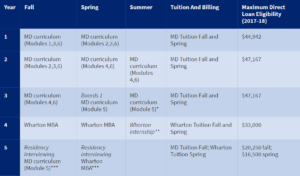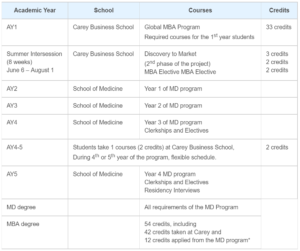Why You Should Consider an M.D./M.B.A. Degree
Healthcare is a business.
In 2005, Cam Patterson finally achieved the role of chief of cardiology at the University of North Carolina at Chapel Hill School of Medicine. He knew all the tricks in the book when it came to fixing hearts, but lacked the financial mastery to fix healthcare. And it needed a big fix. During his second day on the job, Patterson inherited a two million dollar deficit. Realizing his skill set was insufficient, he enrolled himself in the executive M.B.A. program at UNC’s Kenan-Flagler Business School to acquire the expertise needed to navigate the rough waters of money-making. In his own words, pursuing formal business training education was “one of the smartest things [he] ever did.”
In this modern era, as the healthcare industry faces more than a few top-to-bottom changes, administrative knowledge is imperative for tackling enterprise issues that have come into play.
Healthcare — an industry that must balance its altruistic mission with its fiscal pulse — is constantly in flux. With factors such as changing federal policies, biotech innovations, and growth in the medical device and bioinformatics fields, many new issues have risen to the surface. For instance, population management and data analysis are becoming increasingly pertinent.
There is a saying that goes: “healing is an art, medicine is a profession, and healthcare is a business.” In healthcare training, the art and science of medicine is emphasized, while business aspects are generally left for on-the-job learning.
In this modern era, as the healthcare industry faces more than a few top-to-bottom changes, administrative knowledge is imperative for tackling enterprise issues that have come into play. Healthcare is more than just medicine and healing; it is a service rendered in a metamorphic environment. As we saw above, Patterson found himself in a position where learning the business ropes was critical. So, for about two years, he became a student again while simultaneously continuing his work, noting that he was able to immediately implement his learnings. “I would learn something in the evening and apply it the next day at work,” he said.
Throughout the nation, an increasing number of graduate schools are offering a relatively new program of study for individuals aspiring to address the issue of healthcare administration. If what I’ve explained thus far intrigues you, you may want to consider the M.D./M.B.A. dual degree.
Healing is an art; medicine is a profession; healthcare is a business.
What is an M.D./M.B.A. degree?
An M.D./M.B.A. degree is a program of study designed for students interested in pursuing the study of medicine, while gaining expertise in the financial, managerial, and technical realms of healthcare. The program equips its students with the tools to become highly competent physician leaders. Proficient in management and medicine, they can then become influential in the refining of societal healthcare.
Lately, the program’s popularity has dramatically increased as stakeholders have recognized the importance of such business topics as marketing and personnel management. Over the past decade, the number of M.D./M.B.A programs has skyrocketed from merely six to more than 65. The University of North Carolina, Harvard University, and the University of Pennsylvania are among the schools offering this option. For a more inclusive list of all the schools that provide the dual degree, visit the Association of M.D./M.B.A. Programs.
An M.D./M.B.A. degree equips students with the tools to become highly competent physician leaders. Proficient in management and medicine, they can then become influential in the refining of societal healthcare.
What does the M.D./M.B.A. degree track look like?
Let’s take a look at a snapshot of the M.D./M.B.A. track at Perelman School of Medicine at the University of Pennsylvania. The first three years of this five-year program are dedicated solely to working in the MD degree curriculum. M.B.A. studies begin in the fourth year, and generally culminate (based on preference) in a business internship over the summer, which provides substantial work experience in business administration. During the fifth year, the curriculum of both divisions are revisited, each for a semester. The M.B.A. degree program consists of 19 credit units and is earned in partnership with the Wharton School of Business.

Perelman School of Medicine‘s five year curriculum for the combined M.D./M.B.A.
On the other hand, the M.D./M.B.A. degree program at Johns Hopkins follows a different track. The program features a joint partnership between the Johns Hopkins School of Medicine and the Carey Business School. Although it is a five-year program like UPenn’s, the first two semesters are spent in the M.B.A.portion of the program. Students then switch over to the M.D. curriculum during their second and third years of schooling, and finish out both degrees during the fourth and fifth years. Like the business internship that students can pursue at UPenn, Johns Hopkins offers an opportunity known as the “Discovery to Market.”
This is an especially immersive effort to not only expose students to business administration, but also to help them understand the interplay between science, innovation, and commerciality. The ultimate goal is to prepare them for CEO level positions where they can be leaders at the forefront of technology and entrepreneurship. With a background like this, demanding jobs like hospital administration become easier to navigate.

Johns Hopkins University M.D./M.B.A. curriculum structure (example)
Major Benefits of an M.D./M.B.A. Degree
Besides the fancy suffix, an M.D./M.B.A. degree has a vast array of practical advantages. Most notably, it allows for flexibility in professions, credibility in multiple disciplines, and significant career acceleration. A 2014 study conducted at the Wharton School and Perelman School of Medicine quantified trends observed among the physician graduates of their program. It found that M.D./M.B.A. holders increasingly take on management, administrative, and leadership positions as they advance through their careers, and pull away from clinical care.
They also found another interesting trend in careers. Among the 148 respondents, 116 reported having entered and completed residency. However, the more time that had passed since graduation, the less likely it was that subjects identified clinical practice as their primary work sector. Among those who had graduated in the past decade, 46.2% disclosed clinical practice as their primary work.
Compare this with 39.5% in their second decade since graduation and 19.2% in their third decade since graduation. This statistical drop in clinical practice can be attributed to the fact that almost 20% of respondents reported primarily non-clinical roles. Their positions included involvement in a variety of sectors such as biotechnology, pharmaceuticals, marketing, venture capital, business start-up, philanthropy, and government.
Even more surprising, 29 subjects indicated that they did not seek residency after earning their medical degree, and 21 of those were only in their first decade after graduation. Of them, 33.3% reported biotechnology and pharmaceuticals as their primary work, 23.8% disclosed marketing and consulting, 19.0% recorded equity management, and 14.3% indicated entrepreneurship and venture capital.
Surgeon General Vivek Murthy, appointed under the Obama administration at the age of 37, is the youngest surgeon general in history. Murthy holds a M.D./M.B.A. dual degree from Yale and rose to his influential position within a decade of residency completion.
Joshua Goldman, a graduate of the University of Southern California’s Marshall School of Business and Keck School of Medicine, put these facts into salary perspective by surveying 55 M.D./M.B.A. graduates in 2010. He found that the average starting salary for such graduates was an astounding $292,500. Similarly, Windsor Sherrill, Associate Professor of public health sciences at Clemson University, surveyed 22 more career-established M.D./M.B.A. graduates and reported an average salary of $325,000 among them. Four of these disclosed that they were working in venture capital or other non-clinical jobs and were earning annual salaries of more than $600,000. “People are pretty happy overall in terms of a whole number of metrics—their career, their income, their lifestyle, their home life,” said Goldman.

Surgeon General Vivek Murthy
Surgeon General Vivek Murthy, appointed under the Obama administration at the age of 37, is another notable example. As the youngest surgeon general in history, he holds a M.D./M.B.A. dual degree from Yale and rose to his influential position within a decade of residency completion.
In 2010, he co-founded Epernicus LLC, an “internal social networking platform for pharma companies and non-profit research institutes” to “[enable] effective communication and collaboration among researchers and between internal business units.” His path symbolizes the benefits of a dual degree in medicine and business administration.
Through a dual degree, students can pursue medical ambitions, while also finding themselves on a fast track to high-level positions early on in their careers.
“Physicians with training in management are now an essential part of the health care workforce,” says David A. Asch, M.D., M.B.A., professor of Medicine in the Perelman School of Medicine and professor of Health Care Management at Wharton. Advances in healthcare are just as likely to stem from changes in management and financing as they are from scientific discoveries.
“Business education is far more practical than medical education,” Patterson says. He explains that the primary objective in medical school is to learn to pass the board exams. Conversely, the skills he gained from attending business school, such as how to run a meeting, were much more applicable. These practical skills are necessary for successful administration and management.
Using his knowledge in business, Patterson embarked on simultaneously diversifying and integrating to raise efficiency. For example, he merged interventional radiology, cardiology, and vascular and adult cardiac surgery into a single unit. As of 2013, the division had become profitable. As a result of the effort, he says: “We now have 60 new [employed] physicians who are part of UNC’s heart and vascular clinical program who formerly were in private practice.” That development was possible due to his business experience.
Advances in healthcare are just as likely to stem from changes in management and financing as they are from scientific discoveries.“Physicians with training in management are now an essential part of the health care workforce,” says Wharton professor David A. Asch, M.D., M.B.A.
What should I consider before pursuing an M.D./M.B.A. degree?
The possibilities are endless with a dual degree in medicine and business administration. Job security, including flexibility and acceleration, is very promising, and so is the chance to make a difference in medicine, which is ultimately most people’s priority.
If this sounds like an avenue you’d like to pursue, consider three things: time, business experience, and money. The vast majority of dual degree programs span five years. However, if you decide to earn the degrees separately, it will add an extra year to your education. Your ability to start working and earning a salary will be postponed by embarking on this path.
If you’re looking to jump right into your career, it may be a better idea to enter the workforce for a few years, establish yourself in the business field and use that experience to apply for the right M.B.A. and/or M.D. programs down the road. It will definitely make you a more competent applicant.
On the flip side, if you do decide to go ahead with earning the degrees, money is certainly a factor to consider. Tuition for medical school is already a significant sum, and adding on the M.B.A. degree ensures at least another year of payment, which piles on student debt. However, with starting salaries averaging in the $200,000s, student debt may become less of a long-term concern.
With an M.D./M.B.A. degree, job security, flexibility and acceleration are promising, while the chance to make a big difference in medicine may be more pronounced. However, it’s important to consider the extra time and money that this program will require you to invest.
Conclusion
Start your decision-making by visiting the Association of M.D./M.B.A. Programs and perusing the info provided by programs that interest you. Initiate conversation with more physicians and business school graduates and weigh the pros and cons for yourself. Look at the requirements for each of the programs and adjust your studies to accommodate them.
You never know what new passions you’ll find down the road. Adding an M.B.A. degree to your M.D. ensures that the sky’s the limit. So start expanding your horizons today!




